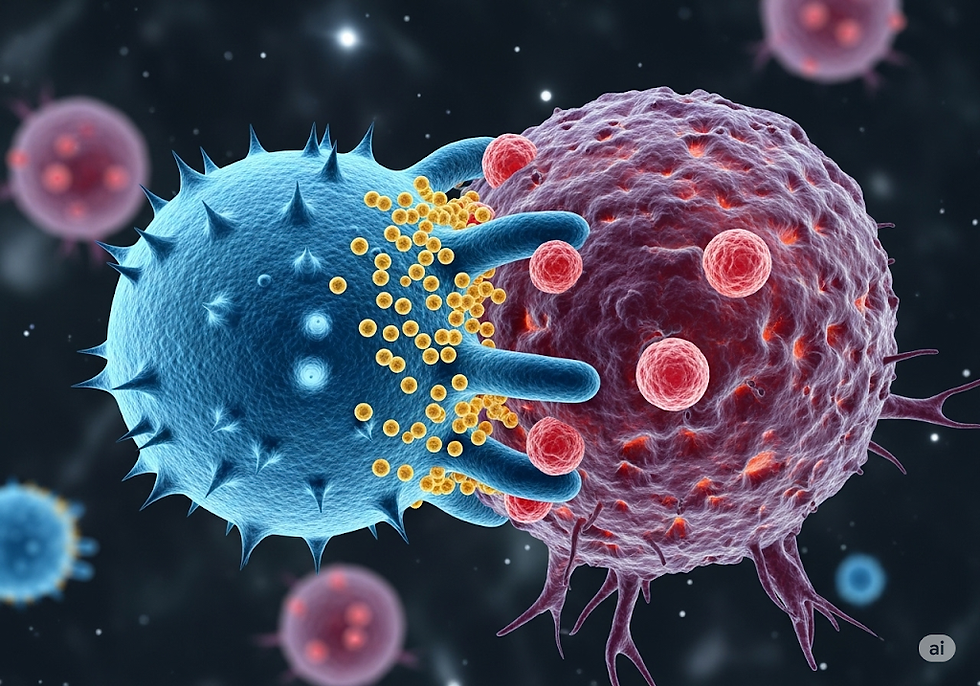The Future of Cancer Treatment: Will CAR-T Cell Therapy Replace Transplants?
- Sunil MAULIK
- Aug 12
- 3 min read

When it comes to cancer breakthroughs, few developments have stirred as much excitement as CAR-T cell therapy—a treatment that modifies a patient’s own immune cells to hunt down and destroy cancer. While it’s already revolutionizing care for some blood cancers, its future—especially in diseases like chronic lymphocytic leukemia (CLL)—is being hotly debated. what’s next for CAR-T? Nig pharmaceutical companies are investing billions into this field.
From Transplants to CAR-T: A Shift in Strategy
For decades, the go-to "last resort" for difficult blood cancers like CLL was the hematopoietic stem cell transplant (often called a bone marrow transplant). This involves replacing a patient’s immune system with that of a donor, which comes with serious risks: infection, rejection, and long hospital stays. Then came CAR-T therapy—short for chimeric antigen receptor T-cell therapy—a sophisticated technique that genetically reprograms a patient's own T-cells (a type of white blood cell) to target and kill cancer cells. These reprogrammed cells are like bloodhounds trained to sniff out specific cancer markers and attack with precision. And because they’re made from the patient’s own cells (a process called autologous therapy), the risk of rejection is significantly reduced.
CLL and the CAR-T Challenge
While CAR-T has shown impressive results in certain cancers like acute lymphoblastic leukemia (ALL) and diffuse large B-cell lymphoma (DLBCL), its effectiveness in chronic lymphocytic leukemia (CLL) has been more limited. This is because CLL often suppresses the immune system in tricky ways that make it harder for CAR-T cells to activate and expand. Researchers are working on ways to overcome this using combination therapies, enhancing the CAR design, and improving how we select patients.
Autologous vs. In Vivo CAR-T
Today’s CAR-T therapies are almost always autologous, meaning each dose is made from a single patient’s cells. This personalized approach, while powerful, is expensive and time-consuming—taking weeks to manufacture. Now, researchers and pharma companies are exploring a bold new direction: in vivo CAR-T. Rather than extracting a patient’s cells, modifying them in a lab, and re-infusing them, in vivo CAR-T aims to reprogram T-cells directly inside the patient’s body, using gene-editing tools like mRNA or viral vectors. Think of it like sending genetic "software updates" directly into the bloodstream. If successful, in vivo CAR-T could:
Cut treatment costs dramatically
Be scaled up for more patients
Eliminate the delays of cell manufacturing
Possibly lead to outpatient therapies, not just hospital-based care
Why Pharma Is Betting Big on CAR-T
The pharmaceutical industry is watching all of this and investing heavily. Here’s why CAR-T is attracting major attention:
Unmet Need: Despite progress in cancer drugs, few patients with advanced CLL are actually cured. CAR-T offers a potential cure, not just control.
High Prices, High Margins: Current CAR-T therapies can cost upwards of $400,000 per patient. While controversial, this price reflects their life-saving potential—and generates interest from investors.
Platform Potential: Once the core CAR-T platform is proven, it can be adapted to other cancers and even autoimmune diseases—unlocking a wide market.
Competition and Consolidation: Big pharma firms are racing to acquire or partner with biotech startups developing next-gen CAR-T, including in vivo approaches.
What’s Next?
Hematopoietic cell transplants won’t disappear overnight, and CAR-T isn’t yet a silver bullet—especially for cancers like CLL that are adept at evading immune detection. But with the rapid evolution of gene-editing, delivery methods, and immune profiling, we may see a world in which:
Autologous CAR-T is reserved for complex or rare cancers
In vivo CAR-T becomes the first-line therapy for many patients
Cell therapies are combined with traditional drugs for long-term remission
Pharma companies shift from chemotherapy pipelines to immunotherapy portfolios
Bottom Line: Hope on the Horizon
If you're a patient, a caregiver, or simply a curious reader, here’s the key takeaway: the future of cancer care is becoming more personalized, more powerful, and possibly more accessible. CAR-T therapies—especially the emerging in vivo versions—represent a profound shift in how we treat disease. Pharma knows this as do scientific researchers. And if the science continues to progress, the next decade could see cell therapy move from the margins to the mainstream.

